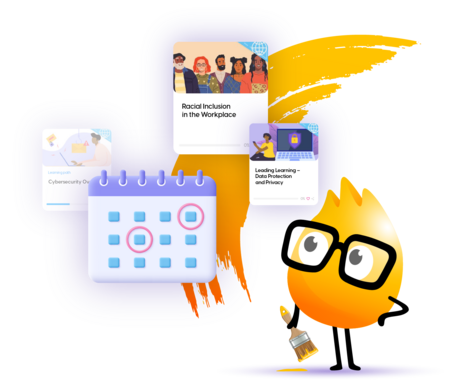The ROI of Training Your Employees
Nothing strikes fear into a training manager’s heart quite like the word “ROI.”
Trying to prove to leadership that a training program is paying off financially is a daunting task: direct evidence may be scant, company leaders might not understand training, and your budget may be on the line. But what if there were a non-financial way to measure the success of your training?
What is ROI?
ROI stands for Return on Investment. Simply put, it’s proof that your training — which your company is likely putting time and dollars into — is paying off financially. Unfortunately, many organizations tend to see training as a cost, rather than as an item that will indirectly increase revenue, and they often want proof that their training programs are increasing their bottom line.
The problem with this is that it’s difficult to prove the ROI of internal L&D programs like employee training because other factors — decisions made in other departments, or the economy — have a more direct effect on a company’s success. Also, it often takes time for training to pay off, so it’s hard to point to a direct increase in the bottom line that correlates to training.
Rather than thinking of your development program as an investment in learning, it may help to think of training as an investment in your workforce. Then you can point to specific improvements demonstrated by your team as proof your training is working. You may want to look at ROE instead.
What is ROE?
ROE stands for Return on Expectations (ROE). When measuring ROE, L&D professionals first work with leadership to define the goals of a training program and then design learning to meet those specific targets.
Those targets might be behavioral (better phone etiquette at a call center), learning-based (everyone understands new product information), or focused on a specific outcome (faster onboarding). Whatever they are, success is measured based on those initial goals.
The Kirkpatrick Model
ROE is based on a 60-year-old system of evaluating training called the Kirkpatrick Model. Developed in the 1950s by L&D leader Don Kirkpatrick, the Kirkpatrick Model evaluates learning programs based on four levels:
- Reaction: How learners feel about the training
- Learning: Whether learners mastered the concepts taught
- Behavior: Whether learners apply the concept at work
- Results: Whether the targeted outcome occurred as a result of the training
Kirkpatrick, who passed away in 2014, called the levels “the chain of evidence” that training is working.
“You get evidence on Level 1 that they liked the program — they thought it was practical; Level 2 that they learned the knowledge, skills and attitudes; Level 3 that they changed their behavior; and Level 4 that you’re going to get the results from it,” he said in an interview.
ROI vs. ROE: Which is a Better for Measuring Training Impact?
Measuring ROE is a more accurate way to know if your training is meeting goals, because you can measure a specific behavior.
And, if that goal behavior has improved, chances are it’s having a financial impact as well (such as lower turnover, or happier customers.)
Below are some goals you can tie to a return on your expectations.
- Job performance
One of the easiest ways to prove the effectiveness of your training is by measuring a specific job activity. If there are specific tasks you want your team to be better at, you can design training specifically for that activity and measure improvement.Let’s say you want your team to get better at following your organization’s sales process. First take a baseline measurement before training, noting how well everyone is following the process. You may collect hard data, like the number of deals closed, and you may also collect anecdotal information, like sales managers’ observations on staff’s performance. After training, gather information again and compare your team’s performance. If they’ve improved, you’ll have proof your training is working. - Retention
According to the most recent retention report from the Work Institute, the cost of turnover to employers has more than doubled since 2009; employers lost more than $700 billion to turnover in 2021. What might that mean to an individual business? The cost of replacing one employee costs roughly 33% of their base pay, according to the Work Institute. For the average US employee, the cost of turnover is approximately $15,000 per worker. Fortunately, training goes a long way to keeping employees around. Many workers value training because they link it with opportunity. A Gallup study found that 57% of workers want skills training from their employers and 48% would be willing to leave their current job for a company that provides skills training. - Career growth
Employees are so interested in training because updated skills mean more room for career growth. Gallup’s study found that workers who had experienced upskilling reported a better quality of life, including increased pay, more fulfilling work, and advancement opportunities within their current organization. This isn’t just a perk for the employees; it’s also good for the company when employees’ talents are nurtured. Take leadership training, for example. There’s a lot of merit in growing your own leadership. Homegrown executives mean that a company is retaining institutional knowledge. Leaders who are promoted from within don’t need to spend as much time learning how an organization works since they’ve been working in that organization, and they’re also automatically a good cultural fit, whereas a CEO who is hired from another company might not be. Leadership training can be challenging; leadership is listed as the fourth most-needed skill in 2023, according to LinkedIn. In fact, it often appears in lists of desperately needed skills. It’s a long game, but by investing in good leadership training, you will eventually be able to show that more managers and (eventually) executives are being promoted rather than hired. - Customer Experience
Are you getting complaints from customers, or worse, are they complaining about your organization on social media? If so, you may need to train for customer experience. A way to do this is to offer soft skills training. Soft skills are people skills; they’re the skills that make your team pleasant to work with: time management, empathy, good listening and communication are all soft skills that customer service reps need to provide exceptional service. While you may think that people are born with these skills and that they can’t be trained, that’s not the case — soft skills are skills. People skills may come naturally to some reps, and others may have learned them on their own, but the rest of your team can learn. The effectiveness of soft skills training can be measured by looking at customer experience metrics. If your customers are happier after your team has been trained, your training is working. - Course completion
Sometimes it’s not the content of your training that needs to change. It’s the way you deliver it. If your team isn’t taking or completing your training, it may be time to look at the technology you’re using to provide training. For example, if you’re not offering mobile training, you may want to consider it. Mobile training makes learning more convenient for your employees because they can take it whenever they have a moment, no matter where they are — especially if your learning has been designed to be consumed in small chunks. Mobile learning can also help remind your employees to train — by pushing out notifications on a schedule. The great thing about changing your course delivery is that the effects are easy to measure and compare; simply measure course completion before and after you change the way you offer learning.
Training often doesn’t affect a company’s bottom line directly, but it does have an immediate impact in other areas — like customer satisfaction, employee happiness, and job performance, and those things often can be measured financially.
When you have other metrics to offer, you can give leadership a more accurate assessment of your training program’s effectiveness, and a better idea of the return they’re getting from learning and development.
Maximize your learning platform’s potential
Now that you’ve explored the benefits of measuring ROE and how it can transform your training programs, it’s time to take the next step. Sign up for a demo today to see firsthand how you can:
- Track and measure the metrics that truly matter to your organization.
- Align training with expectations to drive meaningful change.
- Boost employee performance, retention, and career growth.
- Enhance customer experiences through targeted soft skills training.
- Optimize course completion with convenient and engaging learning delivery.
Don’t miss out on the opportunity to revolutionize your learning and development strategies. Schedule your demo now to see how Litmos can help you drive real learning results!




